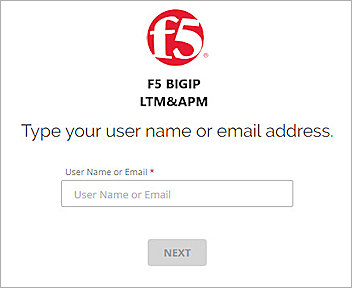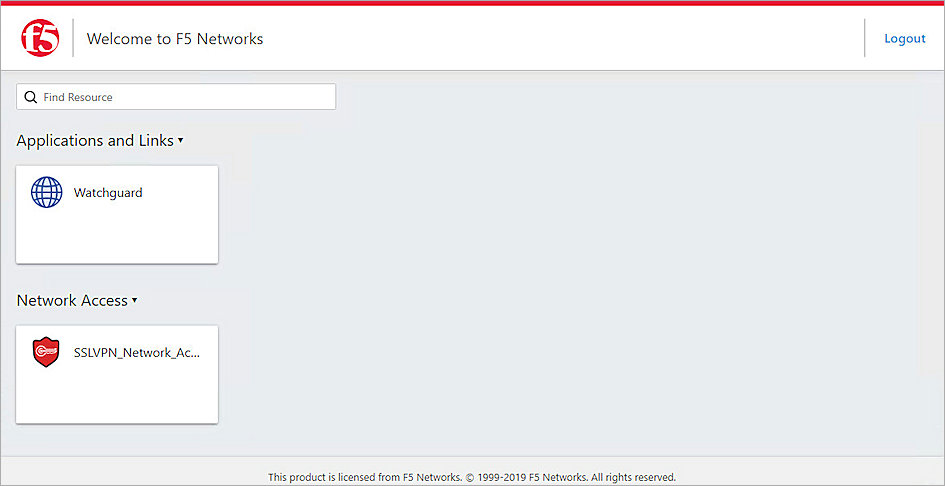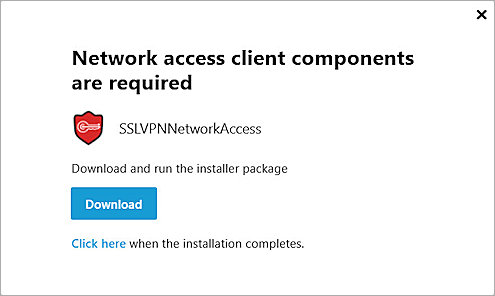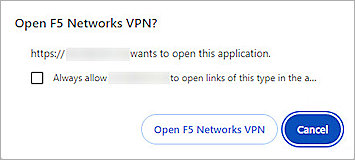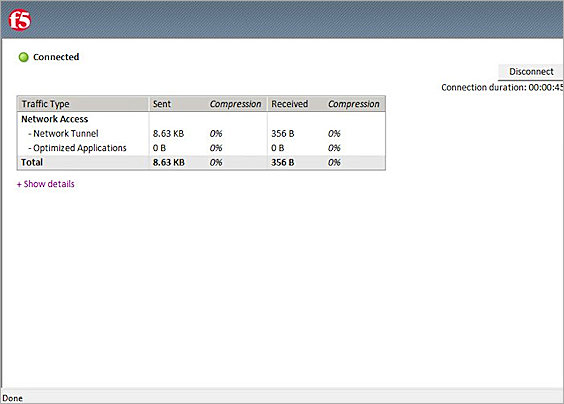Deployment Overview
This document describes how to set up multi-factor authentication (MFA) for F5 BIG-IP Access Policy Manager (APM) with AuthPoint as an identity provider. BIG-IP APM must already be configured and deployed before you set up MFA with AuthPoint.
F5 BIG-IP APM can be configured to support MFA in several modes. For this integration, we set up SAML authentication with AuthPoint.
This integration was tested with BIGIP-17.1.1.3-0.0.5.
Contents
BIG-IP APM Authentication Data Flow with AuthPoint
AuthPoint communicates with various cloud-based services and service providers with the SAML protocol. This diagram shows the data flow of an MFA transaction for BIG-IP APM.
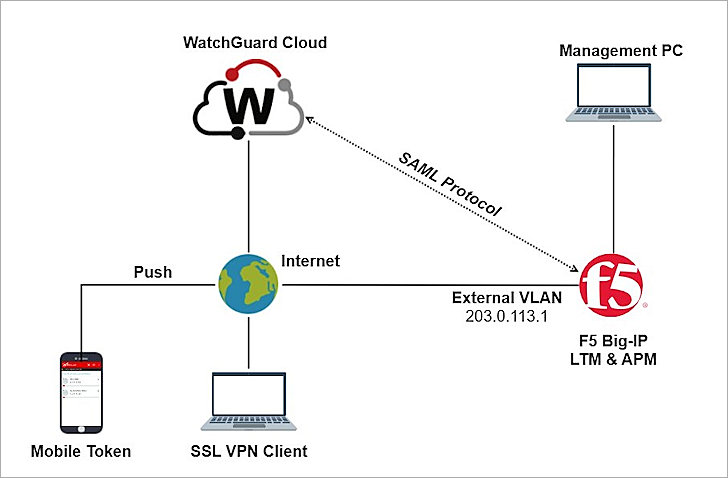
Before You Begin
Before you begin these procedures, make sure that:
- You have installed BIG-IP APM and finished the initialization setup (Setup Utility)
- A token is assigned to a user in AuthPoint
- You have an AuthPoint identity provider (IdP) certificate (go to Certificate Management)
Configure BIG-IP APM
In the F5 BIG-IP Setup Utility, in the Resource Provisioning step, you must change Access Policy (APM) to Nominal. The default is Local Traffic (LTM).
Download AuthPoint Metadata
To start, you must download the metadata file from the Certificate Management page in the AuthPoint management UI. After you have that, you can configure BIG-IP APM.
- Log in to WatchGuard Cloud.
- From the navigation menu, select Configure > AuthPoint. If you have a Service Provider account, you must select an account from Account Manager.
- Select Resources.
- Click Certificate.
- Next to AuthPoint certificate you will associate with your resource, click
 and select Download Metadata and Download Certificate. We recommend that you choose the certificate with the latest expiration date. If you do not have a certificate, or if all of your certificates have expired, click Add Certificate and use the newly created certificate.
and select Download Metadata and Download Certificate. We recommend that you choose the certificate with the latest expiration date. If you do not have a certificate, or if all of your certificates have expired, click Add Certificate and use the newly created certificate.The AuthPoint metadata provides your resource, in this case BIG-IP APM, with information necessary to identify AuthPoint as a trusted identity provider.
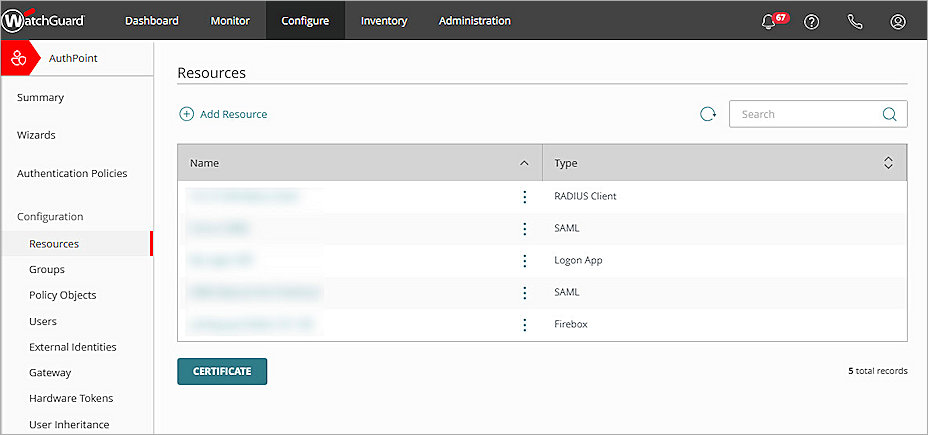

Configure AuthPoint as an Identity Provider
The BIG-IP APM system is a SAML service provider. It sends authentication requests to AuthPoint and receives assertions from the AuthPoint (the identity provider).
AuthPoint must be set as an identity provider. This requires the metadata file that you downloaded in the Download AuthPoint Metadata section.
- Select Access > Federation > SAML Service Provider > External IdP Connectors.
- Select Create > From Metadata.
- Click Browse to select the AuthPoint metadata file you downloaded in the Download AuthPoint Metadata section.
- Type a name for the identity provider (AuthPoint). In our example, we type AuthPoint_SAML.
- Click OK.
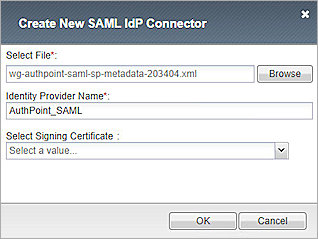
Configure BIG-IP APM as a Service Provider
- Log in to the BIG-IP APM web UI from the management port (https://management port IP address).
- Select Access > Federation > SAML Service Provider > Local SP Services.
- Click Create.
- Type a name for the service provider (BIG-IP APM). In our example, we type BIGIP-SAML.
- In the Entity ID text box, type the external access URL of the BIG-IP APM.
- Leave the default value for all other settings.
- Click OK.
- Select the service provider you created for BIG-IP APM.
- Click Bind/Unbind IdP Connectors.
- Click Add New Row.
- From the SAML IdP Connectors drop-down list, select the IdP connector you created for AuthPoint.
- Click Update.
- Click OK.
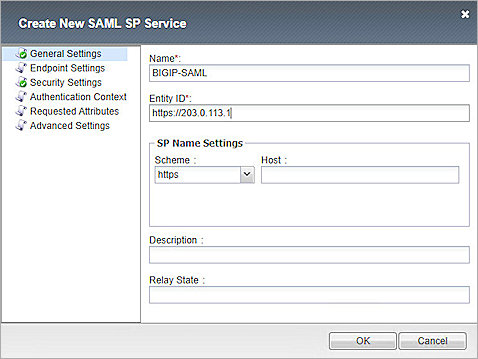


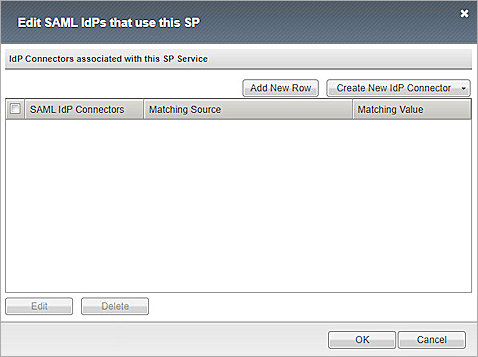
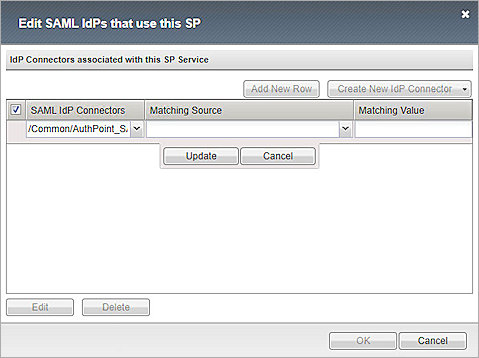
Configure a Lease Pool
You configure a lease pool to associate a group of IPv4 or IPv6 addresses with a network access resource. When a lease pool is assigned to a network access resource, network access clients are automatically assigned unallocated IP addresses from the pool during the network access session.
To create an IPv4 lease pool to provide internal network addresses for network access tunnel users:
- From the Main navigation pane, select Access > Connectivity/VPN > Network Access (VPN) > IPV4 Lease Pools.
- Click Create.
- Type a name for the lease pool.
- For Type, select IP Address Range.
- Type the Start IP Address and End IP Address.
- Click Add.
- Click Finished.
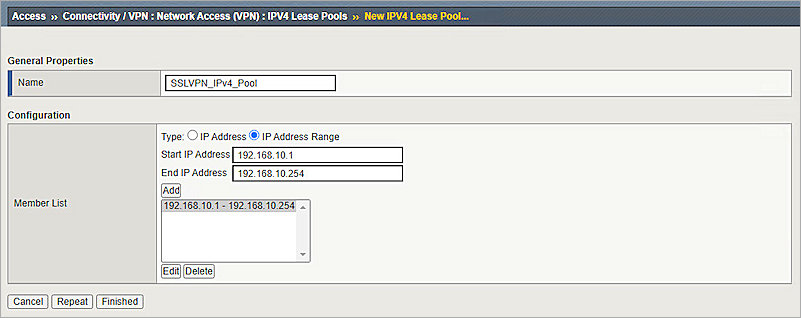
Configure Network Access
The BIG-IP APM Network Access feature provides users with the functionality of a traditional IPSec VPN client. With Network Access, employees, partners, and customers can securely access corporate resources from any location using a standard web browser or the BIG-IP Edge Client.
- From the Main navigation pane, select Access > Connectivity/VPN > Network Access (VPN) > Network Access Lists.
- Click Create.
- Type a name for the Network Access.
- Select the Auto launch check box.
- Leave the default value for all other settings.
- Click Finished.
- Select the Network Settings tab.
- From the IPV4 Lease Pool drop-down list, select the lease pool that you created.
- Leave the default value for all other settings.
- Click Update.
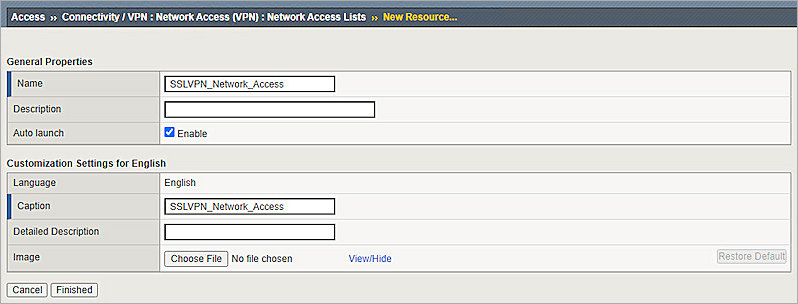
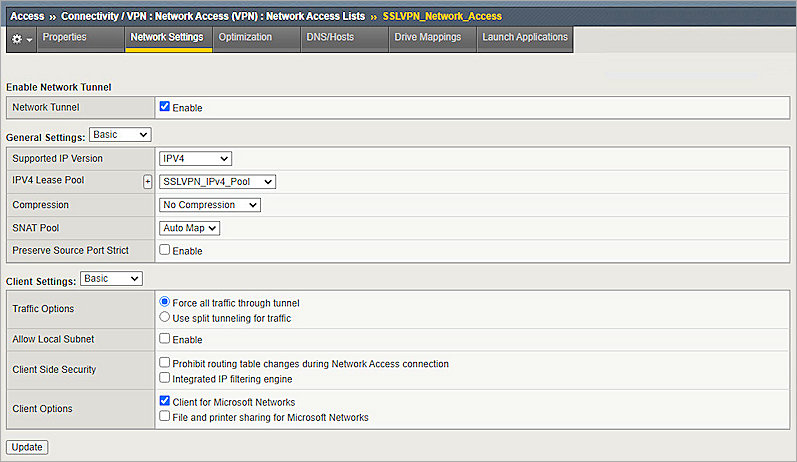
Configure a Connectivity Profile
A connectivity profile is the profile that is selected in a virtual server definition to define connectivity and client settings for a network access session.
- From the Main navigation pane, select Access > Connectivity/VPN > Connectivity > Profiles.
- Click Add.
- Type a name for the Connectivity Profile.
- From the Parent Profile drop-down list, select /Common/connectivity.
- Leave the default value for all other settings.
- Click OK.
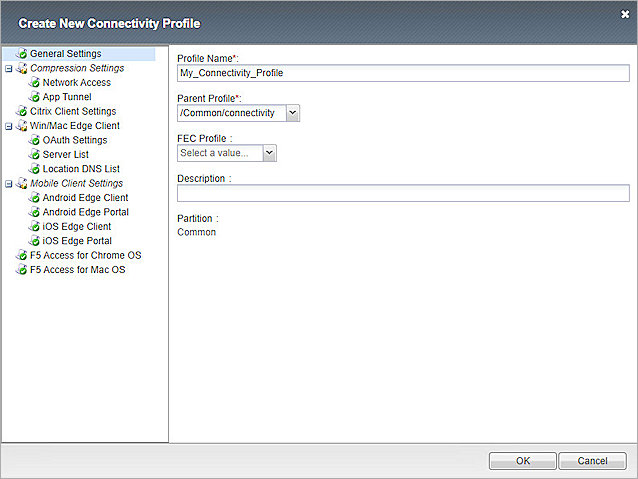
(Optional) Configure Webtop
A Webtop is a remote implementation of a desktop environment that provides the functionality of a local machine. You connect to a Webtop with a web browser.
You can define three types of webtops in BIG-IP APM:
- A network access only Webtop
- A portal access Webtop
- A full Webtop
To configure a Full Webtop:
- From the Main navigation pane, select Access > Webtops > Webtop Lists.
- Click Create.
- Type a name for the webtop.
- From the Type drop-down list, select Full.
- Leave the default value for all other settings.
- Click Finished.
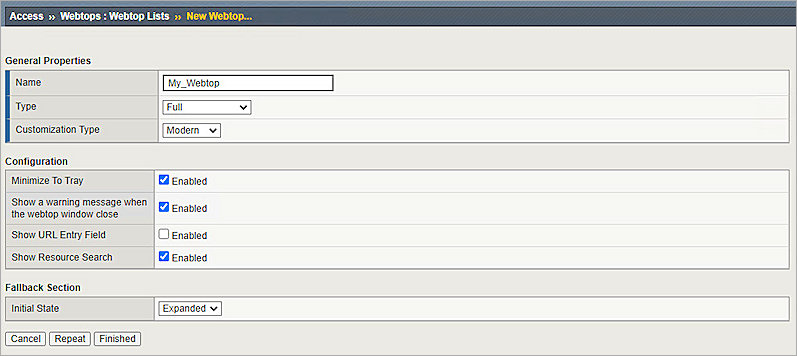
(Optional) Configure Webtop Links
Webtop links are the links to the resources that you add to the Webtop. After the user authenticates, they see links to the resources on their Webtop.
- From the Main navigation pane, select Access > Webtop > Webtop Links.
- Click Create.
- Type a name for the webtop link.
- From the Link Type drop-down list, select Application URI.
- In the Application URI text box, type a URI link. In our example, we type https://watchguard.com/.
- Leave the default value for all other settings.
- Click Finished
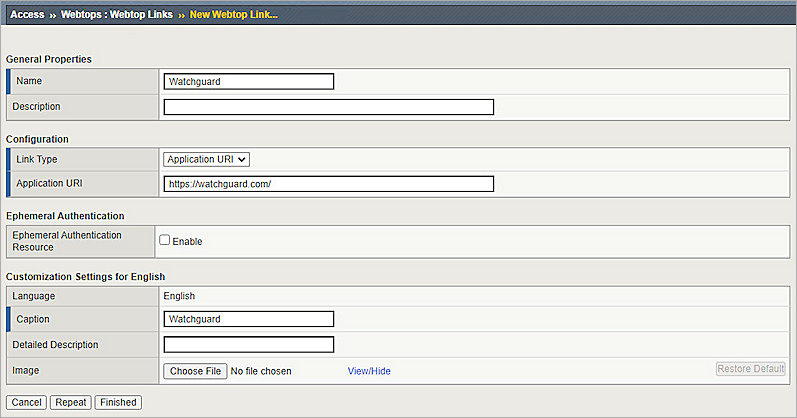
Configure an Access Profile
The access profile is where you define the criteria for granting or denying access to the various servers, applications, and other resources on the network.
- Select Access > Profiles/Policies > Access Profiles (Per-Session Policies).
- Click Create.
- Type a name for the Access Profile.
- From the Profile Type drop-down list, select SSL-VPN.
- In the Language Settings, add English to Accepted Languages.
- Leave the default value for all other settings.
- Click Finished.
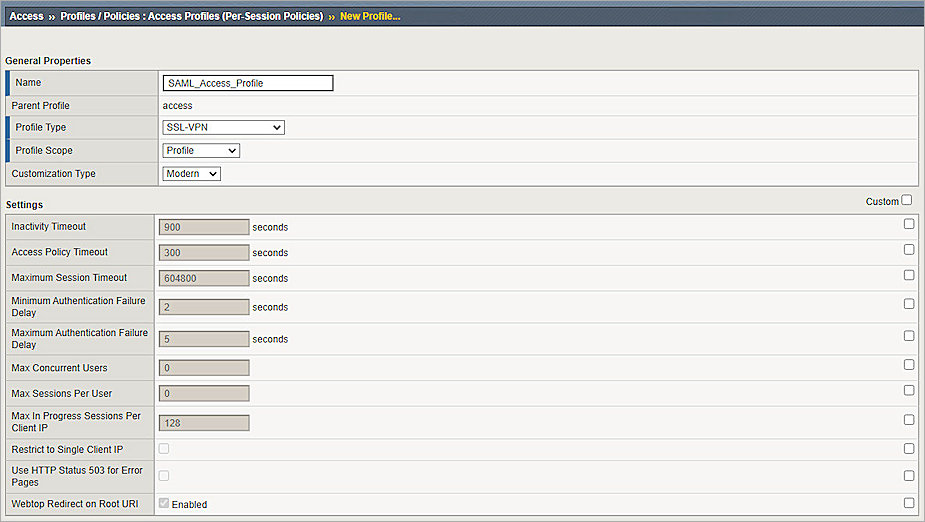
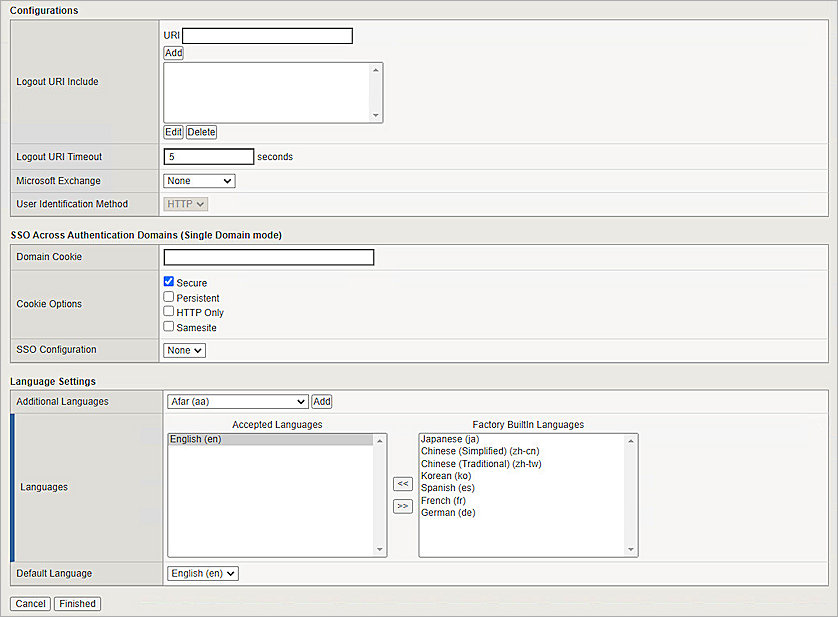

Edit the Access Profile
You can use an Access Policy to define a sequence of checks to enforce the required level of security on a user’s system before that user is granted access to servers, applications, and other resources on the network.
An access policy can also include authentication verifications to authenticate a user before access to network resources is granted.
- In the row of the Access Profile that you added, click Edit.
- Click +.

The first page for a user will be the redirected page for SAML authentication. To add the SAML authentication redirection:
- Under the Authentication tab, select SAML Auth.
- Click Add Item.
- From the AAA Server drop-down list, select the service provider that you created in the previous section.
- Click Save.
- Click Deny next to Successful.
- Select Allow.
- Click Save.
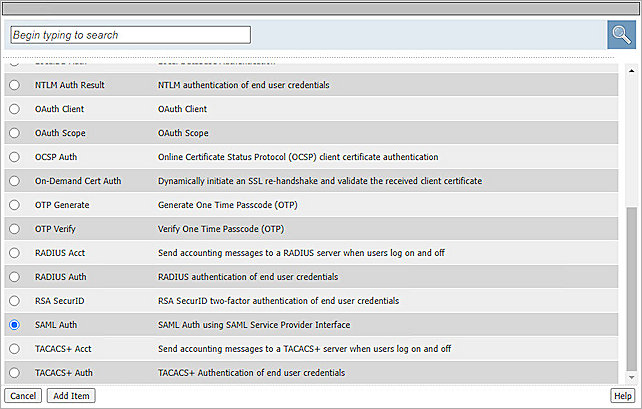
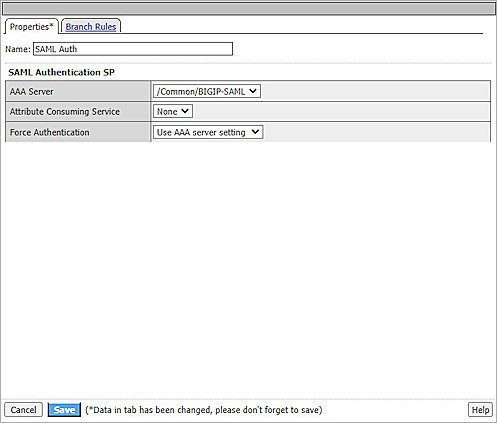
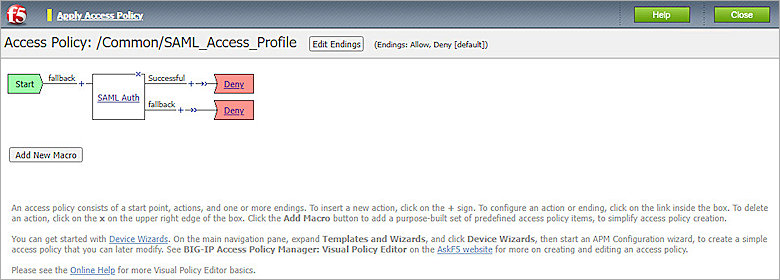

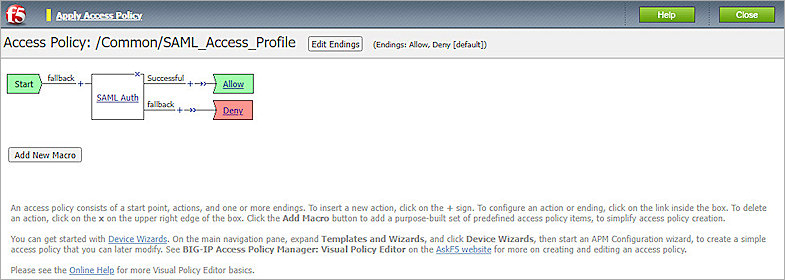
When a user successfully authenticates, they see a webtop with customized resources and a Network Access.
To add a webtop and a Network Access:
- Click the + next to Successful.
- Select the Assignment tab.
- Select Advanced Resource Assign.
- Click Add Item.
- Click Add new entry.
- Under Expression, click Add/Delete.
- Select the Network Access tab.
- Select the Network Access that you created.
- Select the Webtop Links tab.
- Select the Webtop Link that you created.
- Select the Webtop tab.
- Select the Webtop that you created.
- Click Update.
- Click Save.
- To apply the configuration, click Apply Access Policy in the upper left corner.
- Click Close.
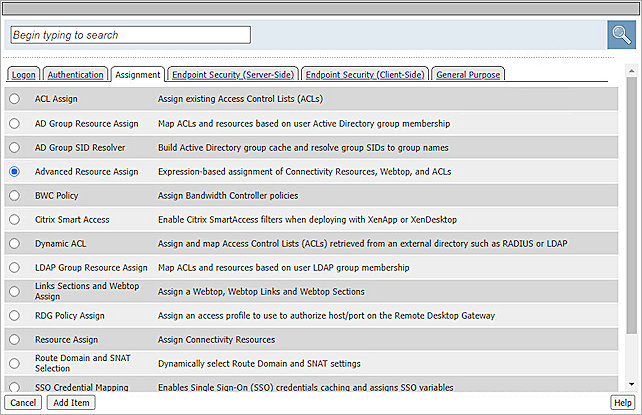
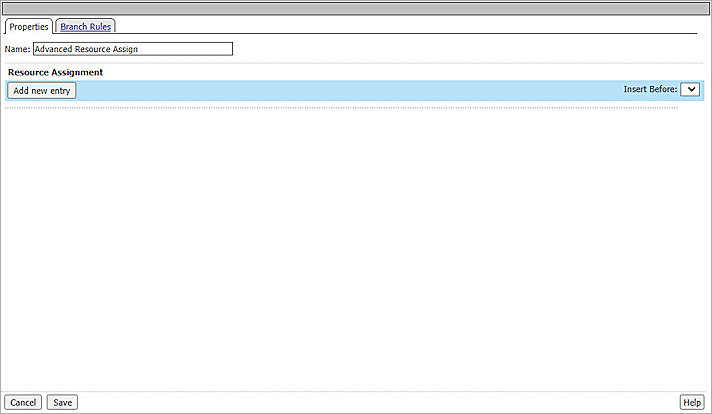
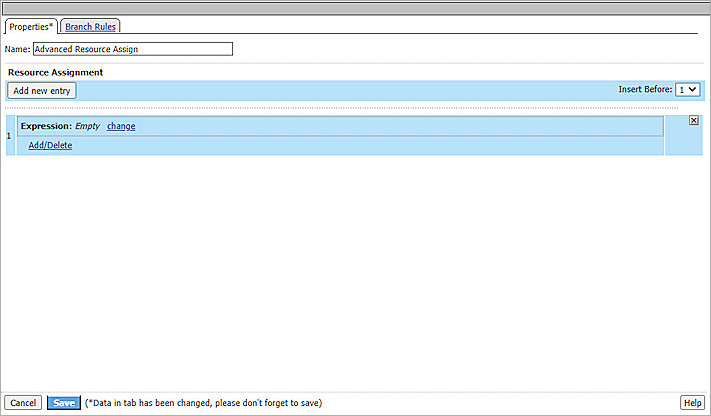

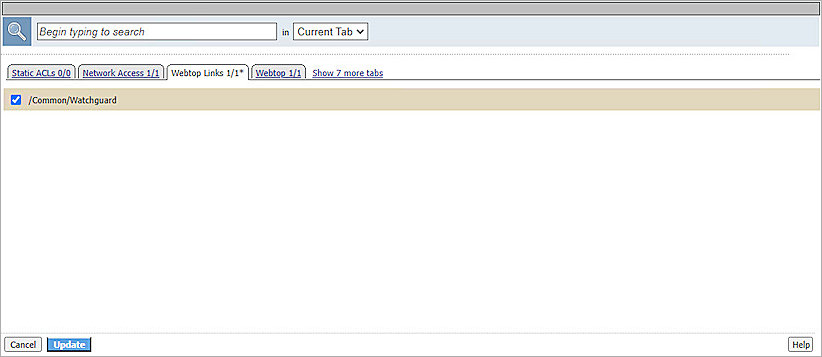

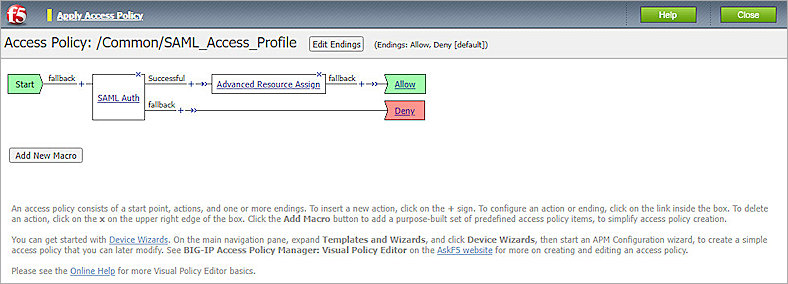
Configure Virtual Server
With BIG-IP APM, virtual servers are configured with specific settings for network access connections or web application access. The IP address assigned to a host virtual server is the one that is usually exposed to the Internet.
You can configure a remote access connection to one or more internal web applications. With web applications, you create an Access Policy and local traffic virtual server so that end users can access internal web applications through a single external virtual server.
- From the Main navigation pane, select Local Traffic > Virtual Servers > Virtual Server List.
- Click Create.
- In the General Properties section, type a name for the Virtual Server.
- From the Type drop-down list, select Standard.
- For Source Address, select Host and type 0.0.0.0/0 in the text box.
- For Destination Address/Mask, select Host and type the virtual server host IP address in the text box.
- For Service Port, select Port.
- From the drop-down list, select HTTPS.
- In the Configuration section, from the HTTP Profile (Client) drop-down list, select http.
- From the HTTP Profile (Server) drop-down list, select Use Client Profiles.
- In the SSL Profile (Client) select the clientssl profile to use with this virtual server.
- In the SSL Profile (Server) select the serverssl profile to use with this virtual server.
- In the Access Policy section, from the Access Profile drop-down list, select the Access Profile that was previously created.
- From the Connectivity Profile drop-down list, select the Connectivity Profile that was previously created.
- Leave the default value for all other settings.
- Click Finished.
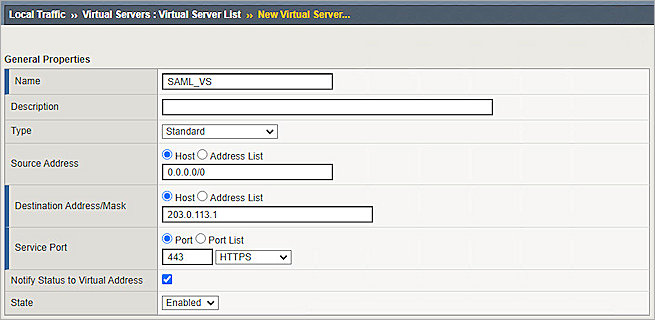
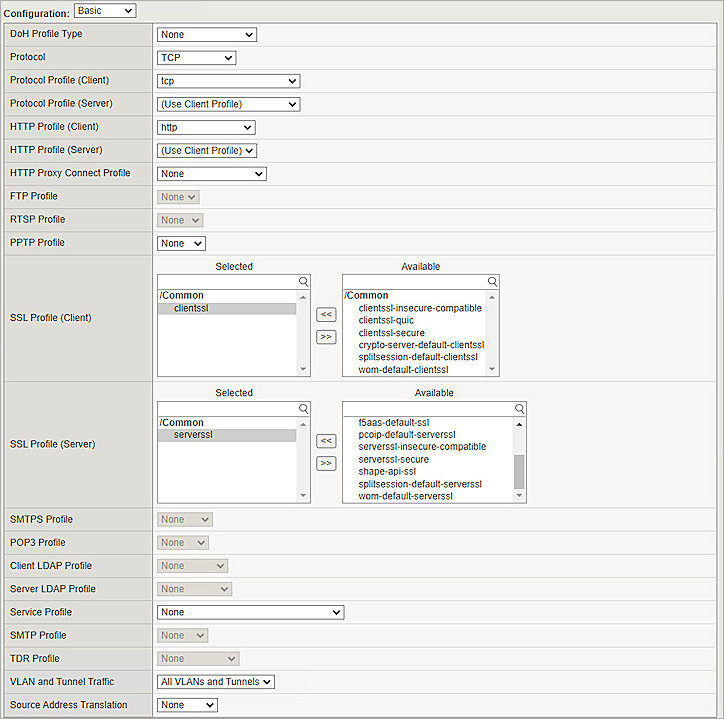
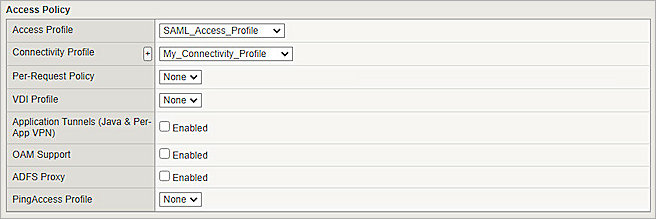
Configure AuthPoint
Before AuthPoint can receive authentication requests from F5 BIG-IP APM, you must add a SAML resource in AuthPoint. You must also create a Zero Trust authentication policy for the F5 BIG-IP APM resource to determine which users can authenticate and log in to F5 BIG-IP APM and which authentication methods they can use (Push, QR code, and OTP).
Export F5 BIG-IP APM metadata
- From the Main navigation pane, select Access > Federation > SAML Service Provider > Local SP Services.
- Select the check box next to your service provider.
- From the bottom of the page, click Export Metadata.
- From the Sign Metadata drop-down list, select No.
- Click Download.


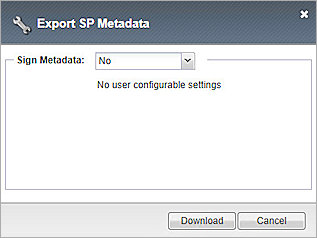
Add a SAML Resource in AuthPoint
From the AuthPoint management UI:
- From the navigation menu, select Resources.
Click Add Resource.
The Add Resource page opens.

- From the Type drop-down list, select SAML.
Additional fields appear.

- In the Name text box, type a name for this resource.
- From the Application Type drop-down list, select F5 Big-IP APM.
- Open the BIG-IP APM metadata file you downloaded and find the entityID and AssertionConsumerService Location values.
- In the Service Provider Entity ID text box, type or paste the entityID value from the BIG-IP APM metadata file.
- In the Assertion Consumer Service text box, type or paste the AssertionConsumerService Location value from the BIG-IP APM metadata file.
- From the User ID sent on redirection to service provider drop-down list, select User Name. The user ID is the attribute for an AuthPoint user that is compared to the user name in your application.
- From the Signature Method drop-down list, select SHA-256.
- From the AuthPoint Certificate drop-down list, select the AuthPoint certificate to associate with your resource. This must be the same certificate that you used to download the metadata file in the Download AuthPoint Metadata section.
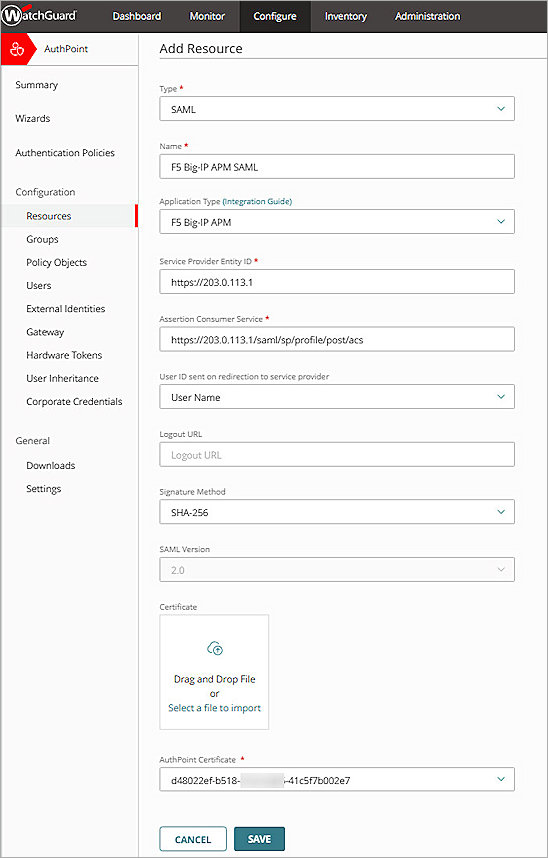
- Click Save.
Add a Group in AuthPoint
You must have at least one user group in AuthPoint to configure MFA. If you already have a group, you do not have to add another group.
To add a WatchGuard Cloud-hosted group to the WatchGuard Cloud Directory:
- Go to Configure > Directories and Domain Services.
- Click the WatchGuard Cloud Directory domain name. If you have not yet added the WatchGuard Cloud Directory, click Add Authentication Domain and select the WatchGuard Cloud Directory.
The New Group page appears.

- In the Groups tab, click Add Group.
- In the Group Name text box, type a descriptive name for the group.
- (Optional) In the Description text box, type a description of the group.

- Click Save.
Your group is added to the WatchGuard Cloud Directory and to AuthPoint.
Add a Zero Trust Authentication Policy
Zero Trust policies specify which resources users can authenticate to and which authentication methods they can use (Push, QR code, and OTP).
You must have at least one Zero Trust authentication policy that includes the F5 BIG-IP APM resource. If you already have Zero Trust authentication policies, you do not have to create a new authentication policy. You can add this resource to your existing authentication policies.
Users that do not have an authentication policy for a specific resource cannot authenticate to log in to that resource.
To configure a Zero Trust authentication policy:
- Go to Configure > Zero Trust. If you have a Service Provider account, you must select an account from Account Manager.
- Click Add Policy.
- Type a name for this policy.
- In the Target section, from the Content drop-down list, select which groups this policy applies to. You can make multiple selections to add multiple groups.
- In the Resources section, select the AuthPoint resources this policy applies to.
- In the Conditions section, select the conditions that apply to this policy. When you add a condition to an authentication policy, the policy applies only to user authentications that match the policy and the policy conditions. For example, if you add a Network Location to a policy, the policy only applies to user authentications that come from that Network Location. Users who only have a policy that includes a Network Location do not get access to the resource when they authenticate outside of that Network Location (because they do not have a policy that applies, not because authentication is denied). For more information, go to About Zero Trust Conditions.
- (Optional) To create a new condition, click Add New Condition. After you create a new condition, you must still add the condition to the policy.
- From the Type drop-down list, select the type of condition to add to the policy.
- From the Name drop-down list, select which condition of the chosen type to add to the policy.
- To add more conditions, repeat Step 6.
If you add conditions to a policy, we recommend that you create a second policy for the same groups and resources without the conditions. Assign a higher priority to the policy with the policy objects. For more information about priority, go to About Zero Trust Policy Precedence.
- In the Action section, select an option to specify whether to allow or deny authentications for the resources in this policy. In our example, we want to allow authentications.
- Allow — Allow user groups in this policy access to the resources associated with this policy.
- Deny — Deny authentications when users in the groups associated with this policy try to authenticate to the resources associated with this policy.
- If you allow access with this policy, select the check box for each authentication option users can select when they authenticate to resources in this policy with MFA.
For SAML resources, if you select more than one authentication option, users must select one of the available options when they authenticate. For example, if you select OTP and Push, users can choose to type their OTP or approve a push to authenticate. You cannot require that they do both.
- Click Save.
Your policy is created and added to the end of the policy list. - Review the order of your policies and adjust as necessary. For more information about priority, go to About Zero Trust Policy Precedence.
Add Users to AuthPoint
Before you assign users to a group, you must add the users to AuthPoint. There are two ways to add AuthPoint user accounts:
- Sync users from an external user database
- Add WatchGuard Cloud-hosted AuthPoint users
Each user must be a member of a group. You must add at least one group before you can add users to AuthPoint.
To import users from Active Directory, Microsoft Entra ID, or an LDAP database, you must add an external identity in the AuthPoint management UI. External identities connect to user databases to get user account information and validate passwords.
- To sync users from Active Directory or an LDAP database, you must add an LDAP external identity
- To sync users from Microsoft Entra ID, you must add a Microsoft Entra ID external identity
When you sync users from an external user database, you can sync any number of users and they are all added to AuthPoint at one time. Users synced from an external user database use the password defined for their user account as their AuthPoint password.
To learn how to sync users, go to Sync Users from Active Directory or LDAP and Sync Users from Azure Active Directory.
You create WatchGuard Cloud-hosted users and groups from the WatchGuard Cloud Directory in WatchGuard Cloud. Directories and Domain Services is where you add shared authentication domains for WatchGuard Cloud devices and services, such as AuthPoint.
Users that you add to the WatchGuard Cloud Directory are automatically added to AuthPoint as well.
You add local AuthPoint users form Directories and Domain Services. You manage the users in AuthPoint on the Users page.
When you add WatchGuard Cloud-hosted AuthPoint users, you choose whether the user is an MFA user or a non-MFA user.
- MFA users are user accounts that will use AuthPoint multi-factor authentication to authenticate. This is not related to the AuthPoint Multi-Factor Authentication license type.
- Non-MFA users are users that will only ever authenticate with a password, such as a service account user. Non-MFA users do not consume an AuthPoint user license and cannot authenticate to resources that require MFA. They can only authenticate to protected resources if the non-MFA user account has a password only authentication policy for that resource.
After you add a user, you can edit the user account if you need to change their account type. When you change a user account from MFA to non-MFA, AuthPoint deletes the tokens and password vault (if applicable) that belong to the user. This action cannot be undone.
Unlike users synced from an external user database, WatchGuard Cloud-hosted AuthPoint users define and manage their own AuthPoint password. When you add a WatchGuard Cloud-hosted user account, the user receives an email that prompts them to set their password.
To learn how to add WatchGuard Cloud-hosted AuthPoint user accounts to the WatchGuard Cloud Directory, go to Add Local Users to an Authentication Domain.
Test the Integration
To test AuthPoint MFA with BIG-IP APM, you can authenticate with a mobile token on your mobile device. For SAML resources, you can choose any method (push, QR code, or one-time password).
In this example, we show the push authentication method (users receive a push notification in the mobile app that they must approve to authenticate).
The user name that you use must be associated with both your AuthPoint and BIG-IP APM user accounts.
To test the AuthPoint MFA:
- Open a web browser and go to https://virtual server IP address.
- Type your AuthPoint user name, then click Next.
- If required, in the Password text box, type your password.
- For the authentication method, select Send Push.
- Approve the authentication request that is sent to your mobile device.
- Click Network Access.
- (Optional) If you haven't installed the Network Access client yet, you need to download and install the Network Access client first.
- Click Open F5 Network VPN.
